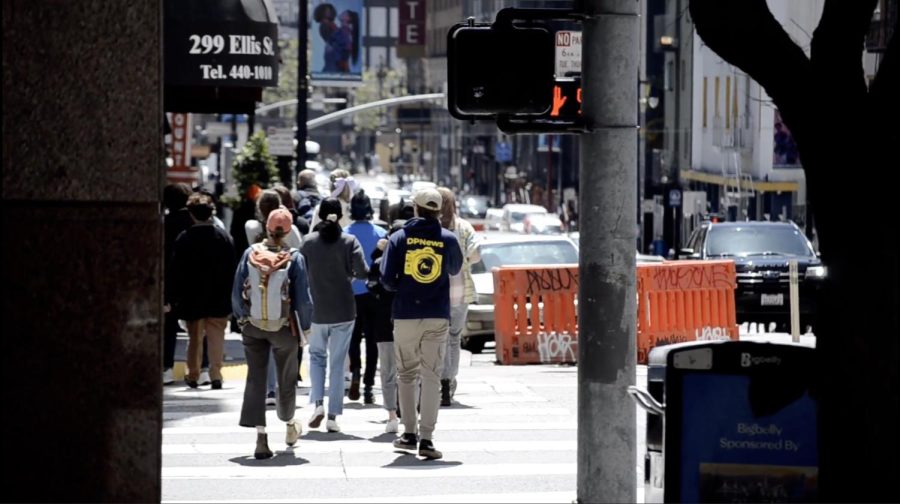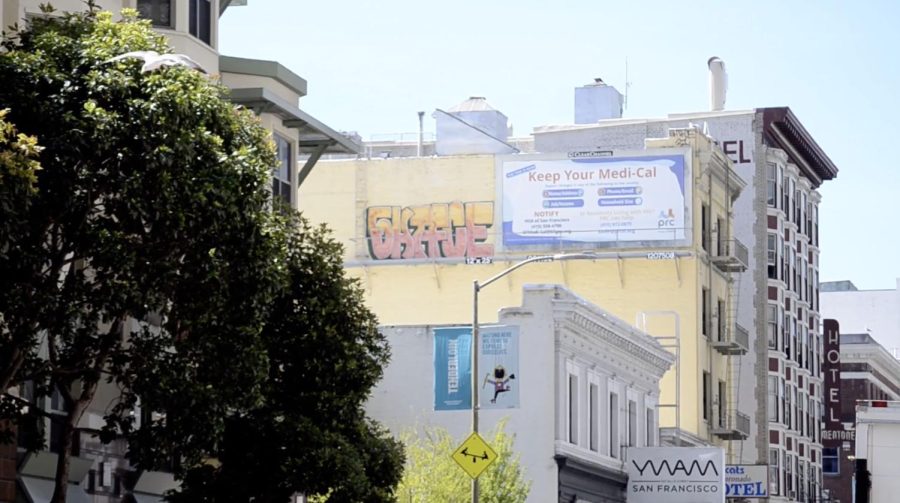“The best the city has to offer”
Behind the media’s depiction of San Francisco’s Tenderloin district lies a diverse community
Tourists and locals walk along the sidewalks of the Tenderloin, taking in the warm afternoon weather and crowded streets. Harker journalism staff members attended the Spring JEA/NSPA Convention in the Tenderloin district from Thursday to Saturday.
SAN FRANCISCO — “Turn right, don’t turn left.”
Security guards stand outside of the Hilton San Francisco Union Square and repeat these words as guests exit the doors, according to San Francisco Chronicle culture critic Peter Hartlaub. These words serve as a cautionary reminder for those stepping into the heart of downtown San Francisco, also known as the Tenderloin.
Most people view the Tenderloin as the most dangerous area in all of San Francisco. Research the Tenderloin online, and you’ll find articles advising you to stay away from the area at all costs. National media depicts the neighborhood as a breeding ground of the homelessness crisis. But how did the Tenderloin acquire this reputation, and does the media paint the entire picture?
Geary Street, Market Street, Mason Street and Van Ness Avenue border the 30-block-district, which gained its notoriety as a result of gentrification. San Francisco’s crime rates are highest in the Tenderloin, amounting to 70% of the city’s violent crimes and a fourth of its murders. This has also contributed to two-thirds of drug crime reports in the city since 2018, making it the district with the most drug offenses.
“I didn’t know much about the Tenderloin before I came here, [but] I thought it was kind of weird that [the security guards] said ‘Turn right, not left,’” convention attendee Devika Raje, a student from Ohio, said. “In a city like this, you will obviously find homelessness and more, but I’m surprised that people aren’t doing any policies or anything to make a change in the region.”
Behind the unhoused, narcotics and those facing struggles with mental health lies the Tenderloin’s rich history, overlooked for over a century. The 1906 San Francisco earthquake and fire destroyed much of the city but also led to a restoration process that incited boisterous activity via entertainment, hotels and brothels that challenged both past and current conservative standards.
As early as 1917, the region embodied the spirit of activism when 300 sex workers protested outside Rev. Paul Smith’s church after his derogatory statements which deemed sex work as a job for “poor deluded women.” The protest catalyzed the exposure of the mistreatment and unsustainable wages that poor and female workers faced.
After the establishment of gay bars, the district became a haven for members of the LGBTQ+ community. In 1966, led by residents of the Compton’s Cafeteria at 101 Taylor Street, community members opposed unremitting police threats against these bars.
“The Tenderloin is often framed as a place that needs to be cleaned up,” San Francisco district 17 assemblyman Matt Haney said in a video clip Hartlaub shared during his keynote address at the Spring JEA/NSPA National High School Journalism Convention on Thursday. “It ended up being another place that I’m very proud to call home now. I’m most proud of and most inspired by many people who have come to the Tenderloin because they’ve been pushed out or discarded or damaged by other places.”
City residents’ reluctance to move to the area eventually proved to be an asset as single room occupancies (SROs) lowered housing prices. Today, the Tenderloin continues to provide affordable housing for city inhabitants through plans implementing 70 new affordable accommodations for low-income residents and 35 units for unhoused adults.
Gradually, immigrants forged a diverse community infused with cultures from nations around the world, while LGBTQ+ activism formulated an inclusive environment that continues to this day. For instance, the Tenderloin fostered the rise of jazz through the Blackhawk jazz club and the essence of new rock and roll through the Great American Music Hall.
“Think about the cultural context of the Tenderloin, all the ways in which it has become a melting pot, the challenges that sort of that can create, but also how much we’ve had to offer, whether it be in terms of music, the civil rights movement, the free love movement, hippies,” local activist and drag queen Honey Mahogany said in a subsequent video clip which Hartlaub shared. “I’m hoping that everyone gets to see not just the physical beauty of the place but also the beauty of the people that live here.”
While the district’s demographic data indicates a crime-ridden neighborhood narrative, it does not reveal the development and growth that defines the community within the Tenderloin.
“Don’t close your eyes to what this neighborhood really is,” Hartlaub said in his keynote speech. “There are children and immigrants and innovators and stories that aren’t being told. I’ve seen some of the bleakest moments of San Francisco in the Tenderloin, but I’ve also seen the best people who look out for each other. If you look behind the headlines, you’ll find the best the city has to offer here.”

Desiree Luo (12) is a co-managing editor for Harker Aquila, and this is her fourth year on staff. This year, Desiree hopes to interview new sources and...

Ananya Sriram (12) is a co-managing editor for the Winged Post, and this is her fourth year on staff. This year, Ananya hopes to bond more with members...

Aishani Singh (12) is a Managing editor for Harker Aquila, and this is her fourth year on staff. This year, she looks forward to interacting more with...


















![“[Building nerf blasters] became this outlet of creativity for me that hasn't been matched by anything else. The process [of] making a build complete to your desire is such a painstakingly difficult process, but I've had to learn from [the skills needed from] soldering to proper painting. There's so many different options for everything, if you think about it, it exists. The best part is [that] if it doesn't exist, you can build it yourself," Ishaan Parate said.](https://harkeraquila.com/wp-content/uploads/2022/08/DSC_8149-900x604.jpg)




![“When I came into high school, I was ready to be a follower. But DECA was a game changer for me. It helped me overcome my fear of public speaking, and it's played such a major role in who I've become today. To be able to successfully lead a chapter of 150 students, an officer team and be one of the upperclassmen I once really admired is something I'm [really] proud of,” Anvitha Tummala ('21) said.](https://harkeraquila.com/wp-content/uploads/2021/07/Screen-Shot-2021-07-25-at-9.50.05-AM-900x594.png)







![“I think getting up in the morning and having a sense of purpose [is exciting]. I think without a certain amount of drive, life is kind of obsolete and mundane, and I think having that every single day is what makes each day unique and kind of makes life exciting,” Neymika Jain (12) said.](https://harkeraquila.com/wp-content/uploads/2017/06/Screen-Shot-2017-06-03-at-4.54.16-PM.png)








![“My slogan is ‘slow feet, don’t eat, and I’m hungry.’ You need to run fast to get where you are–you aren't going to get those championships if you aren't fast,” Angel Cervantes (12) said. “I want to do well in school on my tests and in track and win championships for my team. I live by that, [and] I can do that anywhere: in the classroom or on the field.”](https://harkeraquila.com/wp-content/uploads/2018/06/DSC5146-900x601.jpg)
![“[Volleyball has] taught me how to fall correctly, and another thing it taught is that you don’t have to be the best at something to be good at it. If you just hit the ball in a smart way, then it still scores points and you’re good at it. You could be a background player and still make a much bigger impact on the team than you would think,” Anya Gert (’20) said.](https://harkeraquila.com/wp-content/uploads/2020/06/AnnaGert_JinTuan_HoHPhotoEdited-600x900.jpeg)

![“I'm not nearly there yet, but [my confidence has] definitely been getting better since I was pretty shy and timid coming into Harker my freshman year. I know that there's a lot of people that are really confident in what they do, and I really admire them. Everyone's so driven and that has really pushed me to kind of try to find my own place in high school and be more confident,” Alyssa Huang (’20) said.](https://harkeraquila.com/wp-content/uploads/2020/06/AlyssaHuang_EmilyChen_HoHPhoto-900x749.jpeg)





Joe Mama • Apr 10, 2025 at 11:21 am
this is really good and I think it will help me understand how to read a good news article